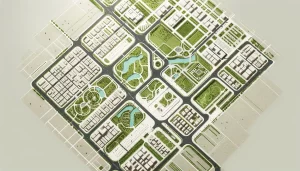Building Cities for Tomorrow
In the fast-paced world of urban development, modern urban architecture stands as a beacon of innovation, sustainability, and community. As we delve into the essential components that define this dynamic field, it’s crucial to understand how these elements interplay to create environments that are not only livable but thrive with cultural and ecological harmony.
1. Sustainable and Green Design
In the heart of urban architecture lies the commitment to sustainable and green design. This principle is not just about reducing the environmental footprint of cities but about creating spaces that promote a healthier lifestyle. Incorporating green roofs, energy-efficient buildings, and natural light can significantly reduce a city’s energy consumption and improve the well-being of its inhabitants.
2. Accessibility and Mobility
A well-designed urban space is characterized by its accessibility and ease of mobility. This means creating pedestrian-friendly pathways, efficient public transportation systems, and ample green spaces that encourage walking and cycling. Urban architecture should bridge the gap between different areas of the city, making it easy for residents to navigate and connect with one another.
3. Community and Social Spaces
The essence of urban architecture extends beyond the physical structures to the creation of vibrant community and social spaces. Parks, squares, and public areas serve as the city’s heartbeat, fostering social interaction and cultural activities. These spaces are crucial for building a sense of community and belonging among city dwellers.
4. Innovation and Technology
Modern urban architecture increasingly incorporates innovative technologies to enhance the quality of city living. Smart cities utilize IoT devices, digital platforms, and data analytics to improve urban services, from traffic management to waste disposal. This integration of technology not only optimizes city functions but also opens new avenues for citizen engagement and governance.
5. Historical Preservation and Integration
An urban environment should not exist in a vacuum; it needs to respect and integrate its historical context. Preserving historical buildings and sites, while blending them with new developments, adds depth and character to the urban landscape. This approach ensures that cities maintain their unique identity while progressing towards the future.
6. Flexible and Adaptable Spaces
The future of urban architecture lies in its flexibility and adaptability. Cities are ever-changing, and so should their architectures. By designing spaces that can evolve with time—whether it’s converting office buildings into residential spaces or repurposing industrial areas for cultural activities—urban architecture can sustainably support the dynamic nature of city life.
7. Health and Well-being
Lastly, the design of urban spaces has a profound impact on the health and well-being of its residents. Natural elements, like water features and greenery, along with sports and recreational facilities, contribute to physical and mental health. Urban architecture should aim to create an environment where people feel safe, happy, and healthy.
 Generated by AI
Generated by AI
Conclusion
In conclusion, the blueprint for modern urban architecture is complex and multifaceted. It’s not merely about constructing buildings but about crafting ecosystems that support sustainable, inclusive, and vibrant urban living. As cities continue to grow and evolve, the principles of urban architecture will play a pivotal role in shaping the future of our urban landscapes.
By integrating these elements, urban planners and architects can create cities that are not just spaces for living but places where communities thrive. The journey towards innovative urban architecture is an ongoing process, one that requires collaboration, creativity, and commitment to improving the urban experience for all.
References:
- Gehl, Jan. Cities for People. Island Press, 2010.
- In this seminal work, Jan Gehl emphasizes the importance of designing cities on a human scale, focusing on public spaces and pedestrian-friendly environments.
- Jacobs, Jane. The Death and Life of Great American Cities. Vintage, 1961.
- Jane Jacobs’ classic text critiques modernist urban planning policies and advocates for more vibrant, diverse, and community-centric cities.
- Congress for the New Urbanism. Charter of the New Urbanism. McGraw-Hill, 2000.
- This book outlines the principles of New Urbanism, advocating for walkable neighborhoods, mixed-use development, and sustainable communities.
- Ingels, Bjarke. Yes is More: An Archicomic on Architectural Evolution. Taschen, 2009.
- Bjarke Ingels presents a unique take on architecture, merging sustainability with innovative design through a comic book format.
- Florida, Richard. The Rise of the Creative Class. Basic Books, 2002.
- Richard Florida discusses the shift towards a ‘creative class’ and how cities can attract and retain talent by fostering an environment of creativity and innovation.
Follow us on our social:
LinkedIn | Facebook | Instagram | YouTube







